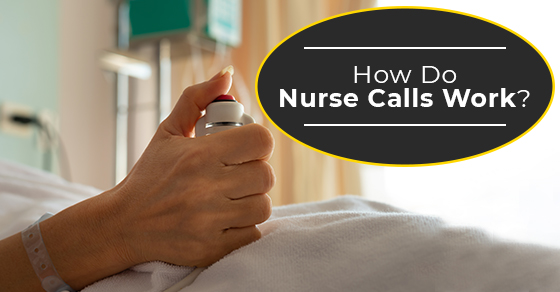How Do Nurse Calls Work?

A nurse call holds an extremely important role at any health care facility. They provide a vital connection between caregiver and patient, which is even more important in case of an emergency. Nurse calls allow patients to communicate their needs with nursing staff efficiently, effectively and affordably. This makes it an excellent option for nursing homes looking for a system that is cost-effective as well as patient and nurse friendly. There are laws that dictate the types of nurse call systems required and the areas in which they must be placed in different medical centers and nursing care facilities to keep them in reach of patients at all times. This demonstrates the essential function nurse calls play in providing urgent care to patients in case of emergencies. Legislation will vary based on the geo-location of a facility to dictate how quickly medical staff must respond to nurse calls.
Nursing homes can greatly benefit from nurse call systems as they provide an extra precaution that allows people of varying health levels to have more independence and a stronger sense of security. Modern nursing systems also provide an opportunity for nursing homes to look at integration with current IT infrastructures to make vast improvements across many different areas. Understanding how nursing calls work helps illustrate how they can improve patient care within your facility.
Why Nurse Calls are Used
Nurse calls provide a simple communication option allowing patients to reach their nurse or a general nurse station with the push of a button. Nursing staff can use them for communication as part of an integrated system with locator options. Visitors can also use nurse calls to reach the nurse for patient assistance. In its basic role, the nurse call is quite simple. However, integrating key medical devices such as IV pumps and ventilators can complicate the system’s function.
There are also varying types of nurse call systems including:
- Nurse Call
- Bed Call
- Bathroom Call
- Wireless Solutions
- Wandering Patient (RFID)
Important Features of Nurse Call Systems
There are many customized features available for modern nurse call systems. However, for the most part, they share the following common features:
- Call Light/Pillow speaker: This is the main part of the system located at the patient’s end. It provides access to contact with the nursing station. However, it also can provide access to other controls such as overhead lighting and televisions. There are also special systems available for those who are unable to activate the system due to paralysis or limited movement. Plug breathe calls into the wall station within these systems. Patients call the nurse by exhaling or inhaling into a tube.
- Wall station: This is the main part of the communication system which acts as the receptacle for the call light. It holds the speaker and communication that allows the patient and nurse to speak to each other. Another important component of the wall station is the code blue button. Connect other important equipment to the station, enabling the nurses’ station to monitor a patient’s equipment, such as IV pumps or ventilators. This is the most efficient way for nurses to receive equipment alarms.
- Bed cable: This connects the patient’s bed to the wall station and provides an alarm to alert nurses if a patient has left their bed. Wandering patients can be tracked using RFID technology. This is very important for patients who should not be leaving their beds unattended. A bed cable can also provide a call button located on the bed rail.
- Desk console: This part of the system looks and acts like a telephone allowing staff to make or receive calls from a patient as required.
- Code blue: Set up Code Blue to send alerts to the nursing station and other areas of the facility. Staff members press the code blue button in emergency situations to alert the team a patient requires immediate assistance.
Assimilation
Design modern nurse call systems to easily assimilate with existing technology within your facility and common medical devices. These devices can include EMRs, cardiac monitoring, telemetry, wireless phones or biomedical equipment. This provides an opportunity for facilities to improve response time by sharing critical information with each other in real time. This approach to interoperability across multiple systems eliminates middleware providing safer practices and greatly improving many procedures. Properly handling assimilation ensures your facility can optimize communication, operations, and ROI.
Seamless Integration
Choosing a nurse call system should work seamlessly with other support resources as well as with existing technologies. The system should assist in enhancing existing or soon to be improved workflows without causing disruptions to the facility. Nurse call systems should be chosen to improve current performance and make it easier for patients to interact with staff.
Each system should be designed to meet the needs of your facility with the appropriate capabilities and functions to improve patient care. Examine current infrastructure closely to address needs and understand technologies requiring replacement. This approach ensures cost-effective upgrades and a better ROI on the new technology.
Areas that many facilities upgrade when installing a new nurse call system could include:
- Electronic Medical Records (EMR)
- Mobile device
- Medical devices
- Real-Time Location Systems (RTLS)
Before selecting a nurse call system, identify all equipment affected by the upgrade to ensure compatibility with existing technology. This will save time and money throughout the implementation process. The IT department will provide valuable input to help identify gaps in the existing infrastructure.
As a project manager overseeing the selection and installation of a nurse call system, gather information about available systems to ensure selecting the proper one. At Fire Monitoring of Canada, we can help you find the perfect solution for your facility. Contact us today for more information.